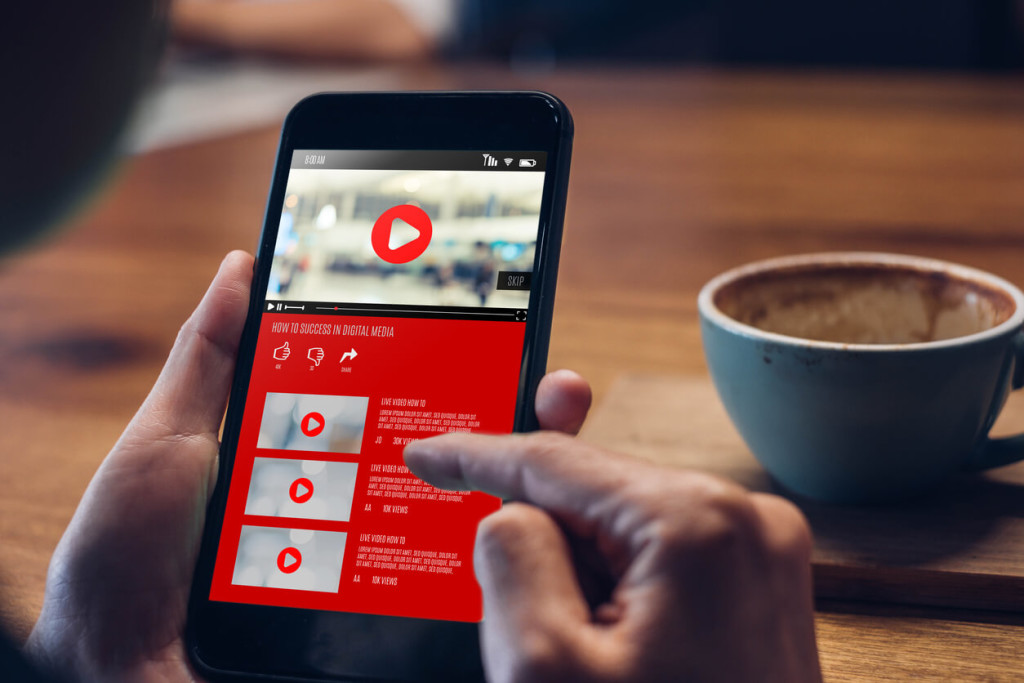Beyond YouTube: Enterprise Video Hosting vs. Free Video Platforms
Video is the fastest growing medium of communication today. Over the past couple of years, many enterprises have caught onto this trend.
The enterprise video platform market is expected to grow at an annual average rate of +18% from 2018 to 2026. Moreover, experts predict this market will reach $915 million by 2026.
Video serves several roles in the professional world. It is used for marketing and promotion, employee training, hosting remote events, product demonstrations, and more.
Since free video hosts, like YouTube, are so easily accessible, it can be tempting to settle for their limited features. However, most of those free video hosts lack the advanced features required to produce a professional-grade broadcast.
Today, we’ll look at why YouTube simply isn’t enough for enterprise video hosting users. We’ll also compare specific YouTube drawbacks to the features of professional streaming solutions. Finally, we’ll dive into how professional enterprise video hosting services work and what sort of features they offer.
Table of Contents:
- Why Isn’t YouTube Enough for Enterprise Broadcasters?
- Uses of Video Content for Enterprises
- Introduction to Enterprise Video Hosting
- 9 Key Differences: YouTube vs. Enterprise Video Hosts
- Conclusion
Why Isn’t YouTube Enough for Enterprise Broadcasters?

YouTube is the most popular free video streaming platform in the world. However, there are many reasons why we don’t recommend using YouTube to stream live for business purposes.
One of the biggest reasons that YouTube isn’t cut out for professional broadcasting is that it’s the third most commonly blocked website in the world. By hosting on Youtube, you’re automatically missing out on viewers who have restricted internet connections.
Another major downfall is that Youtube doesn’t allow custom-branding. Using a video player with third-party logos and advertisements can come across as distracting and unprofessional. It may hinder the user experience.
Enterprise users have special needs that don’t necessarily apply to the consumer market. They need more powerful, flexible, and customizable solutions.
So, what’s the best alternative to YouTube for enterprise broadcasting? The answer is easy: a professional-grade enterprise video hosting platform.
Uses of Video Content for Enterprises

We’ve mentioned a few of the top uses for video content for enterprises, but it is important to emphasize the versatility of this tool.
Here are a few ways that enterprises incorporate video content in everything from marketing to day-to-day operations:
- Employee training and on-boarding
- Internal corporate communications and social
- Customer orientation
- Events (conferences, product launches, conventions)
- Demonstration videos
- Building searchable content databases
One of the uses that we’d like to point out is the ability to host events. The ability to host conferences, webinars and other live events over the internet really widen the possibilities for attendance.
People who may not be able to physically travel to your event can partake from wherever they are. This is especially helpful with the recent need for social distancing.
Introduction to Enterprise Video Hosting
As we’ve covered, there is a great need for advanced enterprise video hosting. Larger businesses simply have needs that Youtube cannot fulfill.
One might describe enterprise video hosting services as custom YouTube platforms. Enterprise streaming solutions don’t have any of the limitations of free services, but they have the same general function.
These services include a wide range of features. A good enterprise online video platform allows you to:
- Upload and share video
- Live stream
- Monetize content
- Gather analytics
- Build custom video channels
- Create mobile apps
Let’s review a few of these key professional features in more detail.
9 Key Differences: YouTube vs. Enterprise Video Hosts

There are nine key differences between YouTube and enterprise video hosting platforms, including access control, security and more.
We’re going to take a close look at these features in order to give you a better idea of what they look like in action.
1. Access Control
As we mentioned, YouTube is the third most-blocked website in the world. In fact, countless businesses, universities, government agencies and other institutions block YouTube. This is a major downside for YouTube and similar social platforms like Instagram, Facebook and Twitter.
In contrast, an enterprise video hosting service is accessible via all platforms at all times. This makes your content available to viewers on just about any internet network.
2. Security
Security is huge when you have hundreds or thousands of valuable files. It is also particularly important if you are collecting payment from viewers.
An enterprise video platform offers countless security features to protect that sensitive information.
These security measures can be as basic as password protection and the ability to set videos to private. However, they also include advanced security features like IP restrictions, referer restrictions, tokenized access control, SSL payment security and HTTPS delivery.
In contrast, YouTube doesn’t offer these advanced features, which is why it’s best for videos that were created for the public.
3. API Access

According to Streaming Media, “The video workflow and distribution environment is incredibly complex, and the way to build a best-of-breed system or even just gain finer control over tasks—especially when delivering video at scale—is by API.”
API stands for “application programming interface.” Essentially, an API is a simplified computer programming language. APIs allow your programmers to write code that interacts directly with the online video platform.
In turn, users can create new solutions that aren’t possible via an online user interface (UI). For example, you can use a video API to create custom web portals, which automatically populate with your video content. Likewise, you can create a streamlined workflow, integrate with existing video and website (CRM, SSO, etc.) systems and more.
With that said, please note that APIs are not available for YouTube. However, APIs do often come with a professional online video publishing platform, like Dacast.
4. SDK Options
The term SDK stands for “software development kit.” Essentially, an SDK is a collection of code snippets, compilers, and other tools. Together, these tools make it easier to use an API for a particular platform. For example, mobile development often utilizes SDKs.
Building mobile apps has the potential to grow your subscriber base hugely. Lately, mobile app usage has increased by 69% year-on-year.
Case-in-point: Dacast has SDKs available for iOS and Android. This makes it much easier to use the Dacast API to build custom video apps for iOS and Android platforms.
5. Powerful Content Delivery
You need a video host that uses a powerful CDN or content distribution network. Simply put, a CDN is a distribution model that supports the fast and reliable delivery of multimedia internet content to a global audience.
Any digital asset that you send via a CDN is copied in real-time. These copies reach a network of hundreds or thousands of servers in disparate geographic locations. When users seek to access your content, they redirect to servers closest to them.
Given this capacity, a CDN provides many benefits. It reduces buffering, speeds up loading times, increases security and redundancy, and allows you to scale up to massive audiences without experiencing problems.
6. Branding and Customization
Branding is essential for enterprise businesses, which need to portray professionalism at all times.
That’s why enterprise video hosting should always include “white-label” video players that allow you to incorporate custom branding and colors. Your platform should allow you to embed videos anywhere with a clean interface that only contains your own logos and colors.
In contrast, free social platforms always include their own branding and colors. Plus, free platforms typically advertise content from other broadcasters alongside your videos. As a result, your video content has a relaxed, non-professional feel to your viewers.
7. Customer Support

Next up, free platforms like YouTube entail no customer support whatsoever. That’s not acceptable for an enterprise that operates critical live streaming or video campaigns.
Look for a platform that includes tech support. Ideally, enterprise video hosts need support available 24/7. For example, enterprise events often take place in the evening or outside regular business hours, so 24/7 support is key.
8. Ads and Monetization
For enterprise video hosting, video monetization is an important tool. The global enterprise video market is expected to reach $40.84 billion by 2022. That’s an annual growth rate of more than 20%.
With YouTube, monetization options are limited and tightly controlled. For the most part, your only option is advertising. Rates are very low and you have very few customization options. For example, you have little or no control which type of advertisements will appear before, during and after your content.
In contrast, professional platforms let you choose between the three major monetization methods: advertising, subscriptions and pay-per-view. Even better, you can mix and match these methods per your needs.
9. Content Rights
When you upload or stream a video with YouTube, you give away content rights.
Let’s quickly review item 6C in the YouTube terms of use:
“By submitting Content to YouTube, you hereby grant YouTube a worldwide, non-exclusive, royalty-free, sub-licenseable and transferable license to use, reproduce, distribute, prepare derivative works of, display, and perform the Content in connection with the Service and YouTube’s (and its successors’ and affiliates’) business.”
Essentially, once your video is uploaded to Youtube, it is no longer yours. This loss of content rights can pose a problem for some businesses and types of content. Instead, choose a platform that allows you to keep all rights for yourself.
Conclusion

To recap, online video represents a massive opportunity for businesses, so investing in an enterprise video hosting platform as an alternative to YouTube and the like will help you begin your broadcasting journey on the right foot.
In this post, we’ve covered many of the most important online video hosting features for enterprise use. Also, we’ve discussed why free platforms like YouTube aren’t ideal for professionals.
We hope this article has equipped you with the confidence you need to navigate the world of enterprise video hosting.
For the next step, we recommend exploring our enterprise video platform comparison. Of course, we recommend testing out Dacast.
You can try our unified streaming platform risk-free for 14-day with our free trial. No credit card required. Access a range of professional services designed to help you set up custom event websites, build video portals, and more. Sign up today to start your free trial.
As always, thanks for reading, broadcasters, and good luck with your live streaming video. And, for regular tips on live streaming, you’re invited to join our LinkedIn group.
 Stream
Stream Connect
Connect Manage
Manage Measure
Measure Events
Events Business
Business Organizations
Organizations Entertainment and Media
Entertainment and Media API
API Tools
Tools Learning Center
Learning Center Support
Support Support Articles
Support Articles